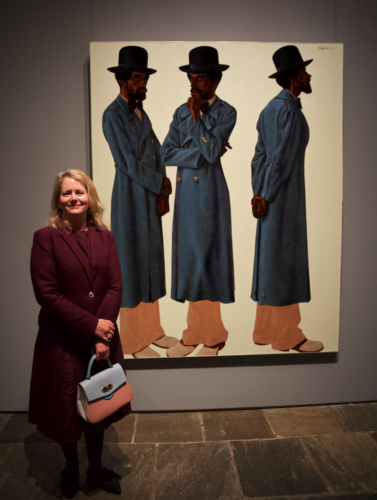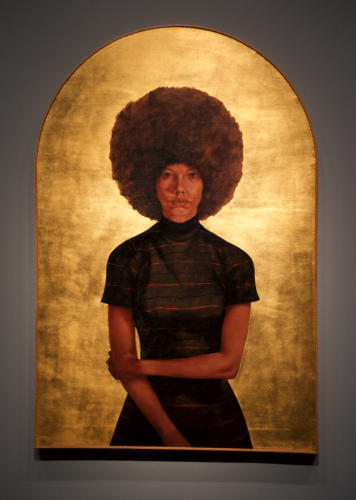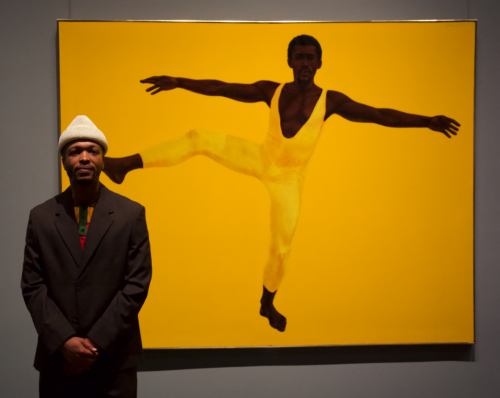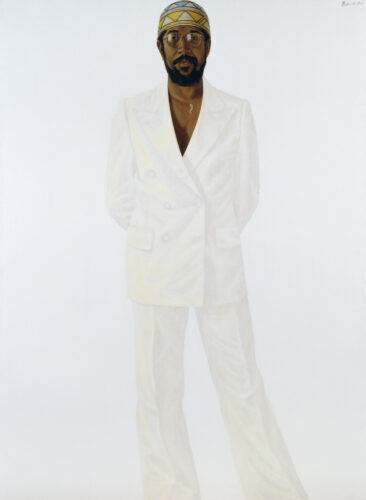The work of Barkley L. Hendricks, the American contemporary artist whose early portraits captured the courage, strength and style of Black America at a critical moment in its history, returns to the site of his first museum appearance this week with the opening of a widely anticipated solo exhibition at the Frick Madison.
Hendricks’ Brown Sugar Vine, a 1970 self-portrait in which the artist appears nude except for sunglasses and a stocking cap, was included in a show titled Contemporary Black Artists in America in 1971 at the Breuer building, which was then the home of the Whitney Museum of American Art. Today, the building is the temporary home of the Frick, which has brought Hendricks back in a show of 14 of his early, life-sized portraits, called Barkley L. Hendricks: Portraits at the Frick. The show opens Sept. 21 and runs through Jan. 7 at Frick Madison, 945 Madison Avenue in Manhattan.
The exhibition is a celebration of Hendrick’s long-underappreciated work, but at the same time it honors the subjects of the portraits themselves. They are young and proud, stylish and smart, a bit detached perhaps, but altogether cool. Though they have the bearing of stars, they are not celebrities, just “friends and family that have a particular style or look,” Hendricks once said. Most look directly at the viewer, their expressions and body language made all the more evocative by the monochromatic backgrounds favored by Hendricks.
Hendricks, who died in 2017, said that in the 1960s he was struck by the dearth of artistic images of Black people that did not focus on what he called “the misery of my peeps?” He set about to change that. “You know, you can always find visual information that deals with the hardship, slavery, and all the rest of it. I’m not denying any of this by any stretch of the imagination, but I’m trying to…address a situation that’s not a part of that,” he said.
The paintings are all life-sized, though hung a bit higher than Hendricks might have liked. The artist said during a 2009 oral history interview with the Smithsonian Archives of American Art that he believed people were more likely to engage emotionally, and for longer periods, when portraits are life-sized.
“If you keep it pretty close to human scale, you have a better chance of having the human that’s looking at it interact with that. So, it’s a compositional as well as a psychological approach about not getting too large or too small. And adding the ingredient that would hopefully catch your eye, that I hope will make it linger,” he said.
Hendricks was a big fan of the Frick, which has of late been looking for ways to highlight contemporary artists along with its spectacular collection of European fine art by the likes of Rembrandt and Vermeer.
It was some of these very artists that inspired Hendricks, who visited museums across Europe while studying at the Pennsylvania Academy of Fine Arts in 1966. During the Smithsonian interview he said he returned from that tour with a new appreciation of the work of Velazquez, Caravaggio, Rembrandt, Vermeer, and Van Dyck along with religious works “of a variety of artists that aren’t necessarily major names, but, you know, they were damned good painters.”
While the show does not include Brown Sugar Vine, it does include another self-portrait, the 1977 Slick, in which Hendricks appears shirtless, in a dazzlingly white double breasted suit, his hands concealed confidently behind his back. He wears glasses and a gold and blue beaded cap. His figure appears against a white background that is only slightly less bright than the suit, making his face, with its expression of blasé confidence and poise, all the more prominent.
If there is one piece that unites the various threads of Hendricks’ early career it is Lawdy Mama, which portrays a Black woman with a commanding afro, a determined stare, and a partial arm cross, her left arm bisecting her midriff as her left hand grasps her right elbow. The piece is an apt reference to Hendricks’ embrace of the old masters and Byzantine iconography, with its use of gold leaf and an arched top that traces the outline of the subject’s hair do. At the same time, it reflects Hendricks’ pop art sensibilities in its limited color palette and monochromatic background.
Hendrick’s work from the period is often thought of as political, a label the artist sought to avoid throughout his career, and Lawdy Mama certainly contributed to that.
He addressed the topic in a conversation with Laila Pedro of Brooklyn Rail in April 2016, one year before he died at 72. “Let me correct the assumption that my early work was explicitly political. I was only political because, in the 1960s, America was fucked up and didn’t see what some artists or what black artists were doing,” he said.
Those searching for political meaning in Hendricks’ early work often pointed to Lawdy Mama, noting the subject’s resemblance to Angela Davis, the 1960s activist, academic and writer. Shortly after the painting was completed in 1969, Davis faced charges related to the armed takeover of a California courtroom for which she was later acquitted.
“It was political in their minds,” Hendricks said in the Brooklyn Rail conversation. “The sitter in Lawdy Mama is my cousin, who had a beautiful ’fro. There are always reactions to that piece from people who thought they knew something about art, thinking it was Angela Davis, or someone like that. No. I did it because it was my cousin,” he said.
The show is yet another signal that the Frick is seeking to appeal to a wider audience by engaging with the work of contemporary artists who were inspired by the Old Masters. In another part of the museum, the work of 18th Century pastel master Rosalba Carriera is shown in collaboration with work by Swiss contemporary artist Nicholas Party.
The show’s co-curator Aimee Ng said the museum’s temporary residency in the Breuer building, which ends next year when renovation of the Frick mansion will be complete, has prompted something of a reexamination of the institution’s modern priorities.
“Here, many of our visitors are new to the Frick, a revelation that has prompted reflection on who the Frick serves, has served, and will continue to serve. This project—the first major museum exhibition and catalogue to focus solely on Hendricks’s early period of portraiture—allows us to consider connections the Frick has made with artists since it became a public museum in 1935,” she said.



